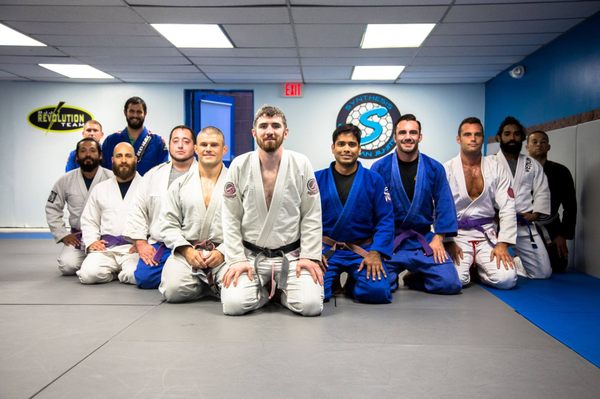
Description
Upholding the premise that most of the advantage of a larger, stronger opponent comes from superior reach and more powerful strikes, both of which are mitigated when grappling on the ground, Brazilian jiu-jitsu emphasizes getting an opponent to the ground in order to use ground fighting techniques and submission holds involving joint-locks and chokeholds.
Common positions in Brazilian Jiu Jitsu are the full mount, side mount, back mount, half guard, knee on belly, and full guard, each of which present a variety of advantages and disadvantages to each fighter.
Lineage
Lineage is incredibly important in Brazilian Jiu Jitsu because it shows the standards and qualifications of instructors and students. A quality school displays its lineage proudly. Lineage denotes the high quality required in every promoted member of the academy.
Synthesis Brazilian Jiu Jitsu is an affiliate Robson Moura Nations United (RMNU) and traces its lineage from resident Blackbelt Collin Schrader, to Robson Moura, to Andre Pederneiras (one of the founders of Nova Union), to Carlson Gracie, to Carlos Gracie, and eventually back to Mitsuyo Maeda.
RMNU Mission
Build and connect Jiu Jitsu families across the world – always growing and learning, because Jiu Jitsu Has No End.
Brazilian Jiu-Jitsu History
Jiu-Jitsu, the oldest form of martial art, originated in India. It spread through China and eventually settled in Japan.
In 1914, Japanese jiu-jitsu champions Esai Maeda and Inomata arrived in Brazil to help establish a Japanese immigration colony in that developing country. He was aided by Gastao Gracie, a Brazilian scholar and politician of Scottish decent. To show his gratitude, the oriental master taught the basic secrets of that ancient fighting style to Gastao’s son, Carlos Gracie.
Carlos taught Maeda’s techniques to his brothers: Oswaldo, Gastao, Jorge and Helio and in 1925 they opened the first jiu-jitsu Academy in Botafogo, a district of Rio de Janeiro, Brazil.
Helio, the youngest brother, who due to his frail health was forbidden from doing any kind of physical activity, got involved in this martial art at the age of 16 when he began substitute teaching for his brother Carlos. In spite of his small frame and weight of only 140 pounds, he became the mastermind behind the development of the style, creating an art that depended entirely upon technique, rather than strength and speed.
Helio went a step further than his teachers by introducing techniques that required less strength than the Japanese style. Led by him, the brothers were driven by a constant determination to find effective ways to deal with the very possible aspect of a real fight. Daring to break away from the traditional Japanese style, they began experimenting, modifying and perfecting simple techniques that would be effective regardless of stature. That is how the Gracie family developed this style of Jiu-Jitsu. Though this martial art descended from the ancient Japanese style, the differences are quite apparent. Many of the Japanese facets of the art which depended on physical prowess and stiff motion were tossed aside, leaving only pure technique.
Location
-
107 Norris Drive Suite D Rochester, NY 14610
Categories
Language
- Engish

Add a review